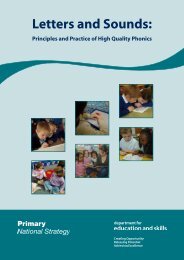Free download of:Excellence in English - Department for Education
Free download of:Excellence in English - Department for Education
Free download of:Excellence in English - Department for Education
You also want an ePaper? Increase the reach of your titles
YUMPU automatically turns print PDFs into web optimized ePapers that Google loves.
11. Castle View Primary School is a smaller than average primary school with a<br />
majority <strong>of</strong> pupils from White British backgrounds. Although many children have<br />
weak literacy skills on entry, standards are above average <strong>in</strong> <strong>English</strong> at the end<br />
<strong>of</strong> Key Stage 2. Every s<strong>in</strong>gle pupil has made at least the expected two levels <strong>of</strong><br />
progress between Key Stage 1 and Key Stage 2 over the past three years. Boys<br />
have made even better progress than girls.<br />
12. Among its many achievements, the school is remarkably successful with writ<strong>in</strong>g.<br />
This can be seen first <strong>of</strong> all <strong>in</strong> the unusually positive attitudes that pupils have<br />
towards writ<strong>in</strong>g. All claim to enjoy writ<strong>in</strong>g. Indeed, a large number <strong>of</strong> the older<br />
pupils write <strong>for</strong> themselves at home. One pupil shared her home-writ<strong>in</strong>g books.<br />
These comprised two beautifully illustrated exercise books (clearly <strong>in</strong>fluenced by<br />
her earlier study <strong>of</strong> The Jolly Postman, with lots <strong>of</strong> <strong>in</strong>serts and cleverly hidden<br />
notes) conta<strong>in</strong><strong>in</strong>g a vast range <strong>of</strong> work; chiefly stories but also poems, lists <strong>of</strong><br />
words, lists <strong>of</strong> favourite read<strong>in</strong>g, and other texts such as the design <strong>of</strong> a<br />
passport. Also, an example <strong>of</strong> an <strong>English</strong> lesson plan, expertly imitat<strong>in</strong>g her<br />
teacher’s approach even down to learn<strong>in</strong>g objectives, warm-up games, an<br />
outl<strong>in</strong>e plan and mark<strong>in</strong>g criteria!<br />
13. The school manages to persuade all pupils that they are writers and to behave<br />
like writers. One teacher said that ‘we believe that all the pupils can be good<br />
writers’ and pupils are certa<strong>in</strong>ly confident <strong>in</strong> their own writ<strong>in</strong>g ability. They talk<br />
about the way that teachers ‘give you just enough help with writ<strong>in</strong>g but not too<br />
much, leav<strong>in</strong>g you free to th<strong>in</strong>k <strong>of</strong> your own ideas’. One simple but effective<br />
strategy is the school’s use <strong>of</strong> high-quality hardback writ<strong>in</strong>g books. These have<br />
high status <strong>in</strong> the school. They are not provided <strong>for</strong> younger pupils and, as a<br />
result, become someth<strong>in</strong>g that these children eagerly anticipate as they get<br />
older. The books have the appearance <strong>of</strong> a pr<strong>of</strong>essional writer’s rough book.<br />
They conta<strong>in</strong> all the pupil’s writ<strong>in</strong>g <strong>in</strong> <strong>English</strong>, <strong>in</strong>clud<strong>in</strong>g first ideas, plans and<br />
f<strong>in</strong>al pieces. Pupils are encouraged to look though their book <strong>for</strong> ideas or to<br />
reflect on the progress that they have made.<br />
14. All teachers also employ the notion <strong>of</strong> a writer’s ‘toolkit’, which is designed by<br />
each teacher to support a particular writ<strong>in</strong>g task and is shared with pupils. This<br />
lists aspects <strong>of</strong> writ<strong>in</strong>g that pupils might try to <strong>in</strong>corporate <strong>in</strong> that task. One<br />
teacher said: ‘We say to pupils that this is how writers work. This is one <strong>of</strong> their<br />
tricks. And then they’re really keen to have a go.’ Another <strong>in</strong>terest<strong>in</strong>g feature is<br />
the use <strong>in</strong> all classrooms <strong>of</strong> a ‘work<strong>in</strong>g wall’. This <strong>in</strong>cludes guidance from the<br />
teacher, word lists, examples <strong>of</strong> first sentences, drafts <strong>of</strong> openers and so on.<br />
The wall gets added to as new guidance is posted on top <strong>of</strong> old but previous<br />
work and h<strong>in</strong>ts can soon be recovered. Pupils say that they f<strong>in</strong>d this really<br />
helpful and it is constantly referred to dur<strong>in</strong>g lessons.<br />
15. Another aspect <strong>of</strong> the approach to writ<strong>in</strong>g is that teachers work hard to make<br />
the writ<strong>in</strong>g purposeful. This is especially evident <strong>in</strong> the Early Years Foundation<br />
Stage where pupils write menus <strong>for</strong> the café role-play area, design signs <strong>for</strong> the<br />
tea party, compose letters after visits and frequently write spontaneously to<br />
other teachers. Older pupils build on this by writ<strong>in</strong>g: programmes <strong>for</strong> the school<br />
<strong>Excellence</strong> <strong>in</strong> <strong>English</strong>: what we can learn from 12 outstand<strong>in</strong>g schools<br />
May 2011, No. 100229<br />
9
















